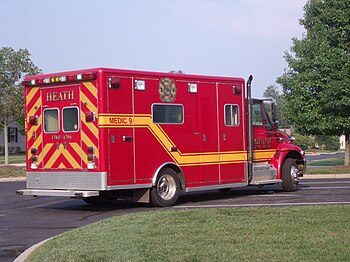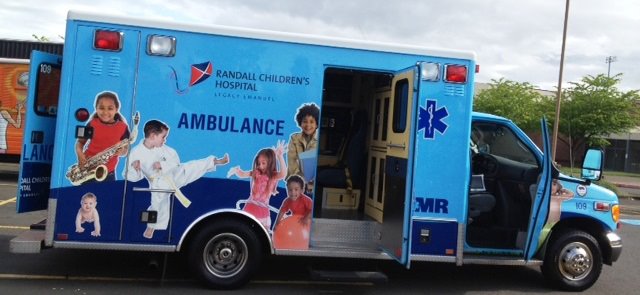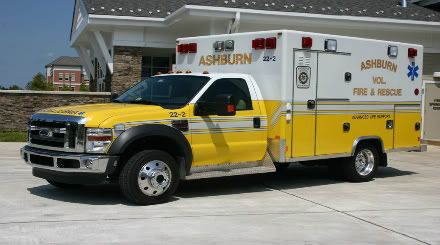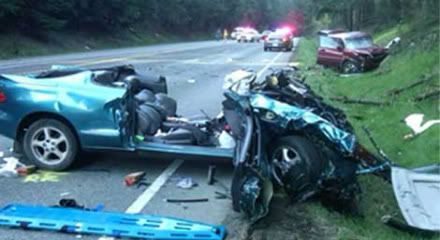New Move To Hands Only CPR
Sure AHA changes the CPR rules every 30 seconds, but this is a welcome change that will stay around a while probably
Professionalism Is Key
Take care to maintain professionalism to the public! You get one shot at the first impression and that impression makes your patient have more confidence in your ability!
Can You Change Death?
Have you really thought about a crash this severe and if how you would handle things if you were first to arrive on scene? If you fall back on your training...is that training good enough to change death to life?
Take Pride in Your Education
Your education in EMS will not only land you a good job but it could save someone's life! You owe it to your patient to be prepared! It's your future but it's their lives!
Tuesday, March 14, 2017
SMCC trains immigrants with medical backgrounds to be EMTs
The new program, believed to be the first of its kind in the nation, is designed to meet a growing need for multilingual emergency medical technicians.
SOUTH PORTLAND — As a physician in the Democratic Republic of the Congo, Jolly Ntirumenyerwa regularly stitched up wounded and bloody bodies, casualties of a long-running civil war that has killed several of her family members and led her to seek asylum here in Maine.
Now, Ntirumenyerwa, who lives in Portland, works two part-time jobs as a health care aide. Like many immigrants, her professional credentials aren’t recognized in the United States. But she dreams of returning to the front lines of medicine, where people need her skills the most.
“I used to work mostly in hospital emergency departments,” Ntirumenyerwa said. “I became a physician because I don’t like to see people sick or in pain. It’s part of my personality.”
Eager to return to her true calling, Ntirumenyerwa is taking a unique course at Southern Maine Community College that is training recent immigrants to become emergency medical technicians. Most of the 13 students in the course are former medical professionals who came from countries such as the Congo, Burundi, Cameroon and Iran. Most of them speak several languages, including French, Persian, Swahili and Italian.
The college developed the noncredit course to address a growing demand for EMTs across Maine and the difficulty that many municipal departments and private companies have in attracting qualified applicants. The college also recognized a ready pool of experienced candidates in Greater Portland’s growing immigrant community and a need for multilingual EMTs who can communicate with patients who have limited English skills.
“There’s a shortage of emergency responders in general,” said course instructor Paul Froman, 29, who is a Biddeford firefighter and paramedic.
“As more immigrants are coming, there are cultural differences that we’re hearing about,” Froman said. “Often, older adults in a family don’t speak English and rely on their children to be translators. That can be a challenge for us in the field.”
GROWING NEED, UNIQUE OFFERING
The college is offering the course, believed to be the first of its kind in the nation, through its Emergency Medical Services/Paramedicine program. It partnered with North East Mobile Health Services, a Scarborough-based medical transportation provider, to launch the program with a $29,300 workforce development grant from the Maine Community College System and additional support from the John T. Gorman Foundation.
North East Mobile Health Services has committed to interviewing students who successfully complete the course. The company anticipates hiring 15 to 20 full-time EMTs or paramedics in the coming year.
“We’re happy to have another pool of potential applicants,” said Sarah Scott, spokeswoman for North East.
Froman said he teaches the immigrant students pretty much the same way he’s taught native-born students for the past eight years. While all of the students speak, read and write English to varying degrees, they also meet separately with a language instructor, who helps them understand complicated regulations, technical language, and cultural differences.
“Because most of them are doctors or have some medical experience, they’ve seen a lot and they know what to expect,” Froman said. “And because they have medical backgrounds, they ask good questions. A lot of medical terminology stems from Greek, so it translates pretty easily.”
The students are taking the same timed quizzes and tests as their native-born counterparts and will receive a certificate if they pass the course, Froman said. Before they can work as an EMT in Maine, they must take a separate test to receive a state license.
PUTTING SKILLS TO WORK
Subjects covered during a recent class ranged from caring for victims of sexual assault to treating patients with hypoglycemia or ruptured abdominal aortic aneurysm. During the clinical portion, students practiced on CPR dummies and each other, asking questions and using basic medical equipment during role playing to determine the status of a patient’s health.
David Ngandu, a physician from the Congo, was partnered with Nicolas Niyonizigiye, a psychologist from Burundi, and Afsaneh Emami, a former nursing student from Iran.
For Ngandu, who is 33 and single, taking the EMT training course is a step toward future employment. He applied for asylum after arriving in Portland last September and he’s waiting for authorization to work, which could take several months. In the meantime, he’s volunteering as an interpreter in Portland public schools and training to become an EMT.
“I want to work in the medical field as soon as I am able,” Ngandu said.
He also plans to put his language skills to good use if he encounters fellow immigrants as an EMT. In addition to English, Ngandu speaks French, Swahili, Lingala, Chiluba and Russian, because he went to medical school in Russia.
“I know I can easily get along with patients who are immigrants,” Ngandu said. “They will know I am a person they can easily talk with.”
Ntirumenyerwa, 37, also speaks French, Lingala and Swahili. She came to the United States in 2012 with her mother, leaving her husband and six children behind in the Congo. Three of her children are adopted nieces and nephews whose parents were killed in the war. While it’s painful to be separated from her family, Ntirumenyerwa forges on, rebuilding her life here, anticipating the day when she is granted asylum.
“I want to work as an EMT, but I’d like to go higher, maybe become a physician’s assistant or a physician again,” she said, smiling. “I wish.”
Kelley Bouchard can be contacted at 791-6328 or at:
kbouchard@pressherald.com
Twitter: KelleyBouchard
Monday, March 13, 2017
Answering the call: EMT class a new challenge as recruits enter next phase of training
After nearly three months, the recruits of Class 21 began their emergency medical technician training last week, embarking on a new, much more rigorously academic portion of the six-month academy.
 |
| English: Medic 9 (Photo credit: Wikipedia) |
“Up until this point, they’ve been in fire classes and fire classes have a lot of hands-on, outside scenarios like the burn building or rescue tech, cutting up cars, that kind of stuff,” said Bernie Studds, a fire medic III called in to teach the nine-week EMT course. “But about 90 percent of the calls we run out in the field are EMS-related, so this would be the best foundation, the greatest foundation that they could have as far as their job as a fire rescuer in Frederick County is concerned.”
While the recruits still have plenty of practical skills to master, the majority of EMT training will take place in the first-floor classrooms of the Public Safety Training Facility rather than in the facility’s burn building or fire tower, said Lt. Mike Webb, Class 21’s lead instructor.
Slated to run through late April, the EMT course will cover a wide variety of skills outlined in a massive textbook with lesson plans covering subjects as varied as on-scene patient assessments, soft-tissue injuries, allergic reactions, shock and spinal trauma, CPR and diabetic shock.
“It’s 1,581 pages,” said Fire Medic III Adam Miller, flipping through the textbook with a grin as recruits practiced CPR on a set of training mannequins nearby. “By the end of this course, they will have read every [page].”
In addition to being much more classroom-oriented, the EMT portion of training is much more challenging in terms of tests and exams the recruits need to pass to continue, Webb said.
“This is what I would consider the most academically challenging class,” Webb said. “Not that the others aren’t challenging, it’s just not as granular. ... [The recruits] have to know things like why the chemistry in the body is doing what it’s doing during very specific emergencies. They also have to know what it’s doing and how to fix it.”
Under the training academy’s rules, recruits may fail and retake a test just once, said Capt. Lenne Stolberg, the commander of the fire service’s training division, who has directly overseen the academy since the beginning of Recruit Class 19.
In the event of a failure, recruits get a remediation period that’s a minimum of three days. It often includes a specific lesson plan developed in conjunction with their instructors before they must take the test again. If they fail a second time, they are dismissed, Stolberg said.
“A good rule of thumb is we lose about 10 percent of a class to various issues,” Stolberg said. “For example, Recruit Class 19 started with a class of 30, of which we lost two during training.”
So far, recruit classes 20 and 21, both of which started with 24 recruits, have each lost one, Stolberg said. Class 21 lost its first recruit on the 42nd day of training — on or about Feb. 6 — the captain said.
Stolberg could not discuss details regarding any specific recruit’s dismissal from the academy, but common reasons include academic failures, injuries — new or aggravated — behavioral issues and recruits simply deciding not to continue for personal reasons.
Speaking generally, Stolberg agreed with Webb that the emergency medical portion of the academy is notoriously tough on recruits.
“There was a time when EMT was the first class we did right out of the gate because it tends to have the highest attrition rate,” Stolberg said. “But I think the way we have it right now is better because it gives us a little more time to identify those recruits who may just have some issues with testing performance. We can build those skills and build that confidence if we can identify those issues ahead of time.”
Webb and his fellow instructors were also doing their part to ensure that the recruits receive plenty of help in the coming weeks.
Many of the recruits with previous experience as volunteer firefighters have already passed the National Registry of Emergency Medical Technicians’ test, which their less experienced classmates will have to take in April. The class was broken up accordingly, Webb said.
Each recruit who will need to take the registry exam in April was seated next to a classmate who had already passed the exam and a fellow recruit who will also have to take the exam, Webb said. The idea is that each recruit who will have to take the test will learn alongside a more experienced mentor as well as a de facto “study buddy” during the next few weeks, Webb said.
The recruits were also taking the challenge seriously, Webb said, scrolling through a list of anonymous encouragements the recruits have written on sticky notes and left hanging near the front of the class.
“Recruit [Phillip] Tracey has been coming in early and staying late to study,” Webb said, reading one of the notes. “It is evidenced by his involvement in class discussion and his willingness to answer questions.”
Webb pointed to another note farther down the list, past several encouragements are written by recruits commending Studds in his first teaching appointment with the academy.
“This one says, ‘Recruit [Ryan] Bowe helped me study in [the] morning, week of [2/19],’” Webb said, smiling as he noticed the third note near the top of the list. “And this one, which kind of proves that point, it calls out the entire class: ‘RC 21, for finally starting to come together,’ and they underlined ‘finally.’”
Follow Jeremy Arias on Twitter: @Jarias_Prime.
Sunday, March 12, 2017
Louisville EMS slammed with 151 overdose calls
 |
| English: Louisville Metro EMS (LMEMS) Transport Ambulance (Photo credit: Wikipedia) |
The city's top health official told some council members Wednesday that "Louisville needs to grow up" and offer more medication-assisted treatment since abstinence-based programs don't work for everyone.
Some treatment programs don't allow methadone, Suboxone and Subutex to try to wean addicts off stronger drugs, said Dr. Joann Schulte, who heads the Metro Department of Public Health and Wellness. Critics of using drugs in treatment say this method can merely substitute one addiction for another.
Following local and national news reports on recent overdose spikes, Schulte joined Louisville Metro EMS Director Jody Meiman and police officials in giving updates to the Community Affairs, Housing, Health, and Education Committee on the addiction crisis and how it is evolving.
Starting at midnight Thursday, EMS fielded 151 overdose calls in four days, according to Metro EMS.
Schulte said she repeatedly has been asked if the city's addiction and overdose epidemic will ease soon.
"My answer is 'No,'" she told the council.
The high volume of emergency calls ranged from overdoses linked to heroin as well as prescription pills, alcohol, other illicit drugs or a mix of drugs, said Mitchell Burmeister, a Louisville Metro EMS spokesman.
It's unknown whether heroin laced with something stronger contributed to the spike. Hospitals treat opioids in general and don't test to see which one caused a non-fatal overdose.
There were 695 overdose cases through the first month of 2017, a 33 percent increase from last year, Burmeister said. Louisville also suffered a March overdose spike and an August rash of overdoses.
Louisville Metro Police Maj. Eric Johnson said the force has already administered 123 doses of naloxone, a heroin, and opioid antidote, to 89 people this year. That compares to all of January and February of last year when they treated just 33 people.
While efforts to save lives have intensified, so have measures to punish dealers. Narcotics Lt. Chuck Mann said detectives have seized more than 57 pounds of heroin this year, including a bust at a St. Matthews apartment complex last week that netted 36 pounds.
Councilwoman Vicki Aubrey Welch, a retired nurse, asked if methamphetamine and meth labs were still a significant problem in Louisville, but was assured heroin is a much larger threat now.
Police and health officials also repeated warnings about fentanyl, a drug Welch remembers hospitals using to treat patients' pain after surgery. The synthetic opioid, which can be up to 50 times more potent than heroin, is increasingly hidden in batches of heroin or other drugs, including fake prescription pills. Fentanyl is blamed in 139 overdose deaths last year, according to Jefferson County coroner data.
Councilwoman Barbara Shanklin asked if first-responders were concerned about carfentanil, an elephant tranquilizer up to 100 times more potent that fentanyl. The Courier-Journal reported Sunday about the city's first confirmed death blamed on the drug, which was never approved for consumption by humans.
Council president David Yates questioned why police don't issue citations to those who survive overdoses, using the criminal charge as leverage to force addicts into treatment.
The police major said often the drug is consumed, leaving behind only drug residue or paraphernalia. And judges typically require more proof to substantiate a charge, he said. Police also pointed to a state law that blocks those charges when someone seeks help in an emergency with the main goal reviving the person who overdosed.
Reporter Beth Warren can be reached at (502) 582-7164 or at bwarren@courier-journal.com.
Friday, March 10, 2017
International Consensus On Sepsis
In February 2016, findings were published in The Journal of the American Medical Association after a task force with expertise in sepsis pathobiology, clinical trials, and epidemiology came together to study current sepsis information. The task force was formed by the Society of Critical Care Medicine and the European society of Intensive Care Medicine (Angus & Singer, 2016, p. 801).
Definitions and clinical criteria were reevaluated and assessed and then finally a lot of septic issues were rewritten or made increasingly clear.
Key Findings of the Taskforce are:
· It is now misleading to excessively focus on inflammation when dealing with sepsis.
· It is now misleading to depend on the SIRS criteria models.
· Many of the current sepsis definitions were found to be redundant and it was recommended they not be used any longer. i.e., ‘Severe Sepsis’
Understanding sepsis more in depth requires one to understand that sepsis is a syndrome of biochemical abnormalities, pathologic and physiological abnormalities that is induced by infection. In the United States alone sepsis accounted for more than $20 Billion in total US hospital costs in 2011 (Angus & Singer, 2016).
Sepsis is now the leading cause of death in the hospitalized patient (Deutschman & Tracey, 2014, p. 463). Sepsis now has over 1,000,000 new cases annually within the United States, and unlike most illnesses, it has up to a 50% mortality rate (Deutschman & Tracey, 2014)
There is no specific treatment for sepsis, no specific medications for sepsis and sepsis drains billions from society due to the patient having to spend weeks and sometimes months with hospitalization. There is no specific patient with sepsis, it spans across all age groups, nationalities, genders, etc.
Deutschman, C., & Tracey,
K. (2014, April 17). Sepsis: current dogma and new perspectives. immunity 40, 463-475.


































